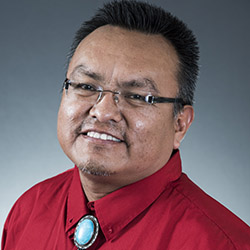Shawn Secatero
Associate Professor
University of New Mexico-Main Campus

Shawn Secatero, Ph.D. is an Associate Professor at the University of New Mexico College of Education and Human Sciences. He is from the Tohajiilee Navajo Community and also serves as an adjunct faculty with New Mexico State University Grants. Dr. Secatero's research interests are holistic education, Indigenous leadership, dual enrollment, and Wellness. He coordinates the NALE (Native American Leadership in Doctoral Education), POLLEN (Promoting Our Leadership, Learning, and Empowering our Nations), AIPEC (American Indian Professional Educators Collaborative), and SENAI (Striking Eagle Native American Invitational) initiatives as part of the Native Education in Sovereignty in Teaching and Leadership (NEST-L) Program at UNM.
Conference Topic:
Indigenous/Traditional Wisdom for Resilient Communities
Title:
The Corn Pollen Model: Connecting our Spiritual, Mental, Physical and Social Well-Being Attributes during and after the COVID Pandemic.
Description:
As part of this workshop, participants will learn about the spiritual, mental, physical, and social well-being components of the Corn Pollen Model, which is a holistic framework designed to include an additional 12 wellness and leadership sub-pillars. In addition, we will examine issues regarding the COVID-19 Pandemic by reconnecting these concepts into the pillars of the Corn Pollen Model. These sacred concepts includes a growth model that include the following:
- Remember the roots of your foundation – spiritual well-being
- Grow your leaves of knowledge – mental well-being
- Standing strong as a corn-stalk – physical well-being
- Sprout your tassels for your people – social well-being
According to Navajo elders, the sacred symbol of corn consists of four main quadrants that include the roots, leaves, stalk, and tassel. The first part of corn includes the roots and seeds, also referred to as “Naadaa’ bi’kelool,”in the Navajo language, of our being that provide purpose or spiritual well-being that provide the foundation for our existence. The symbolic roots of the corn serve as our spiritual connections to the earth through cultural, linguistic, and artistic well-being The second part of the corn includes the corn leaves or “naa’daa’ bit’aa,” in the Navajo language that elates to knowledge and learning. The corn leaves represent our knowledge systems which correlate to mental well-being. These embedded pillars of emotional, intellectual, and technical well-being pillars further promote the concepts of mindfulness, and thinking processes. The cornstalk, also called, “Naa’daa’ Bikaaz,” is the third part of corn that promotes our physical well-being that upholds stability to provide strength and resilience. The corn stalk refers to physical well-being, which relates to self-care and health. This bonding strength of physical well-being refers to additional sub-pillars including the environmental, cyclical, and medicinal well-being sub-pillars. Finally, the corn tassel which is referred to as Naadaa’ bi’zool, in the Navajo language and is the fourth part of the corn pollen model that signifies our acknowledgement of success and persistence. The corn tassel serves as a symbol of our social, professional, economic, and political well-being pillars. These examples of relationships, professional well-being, economics, and political attributes represents a holistic pathway to honoring leadership and education.


